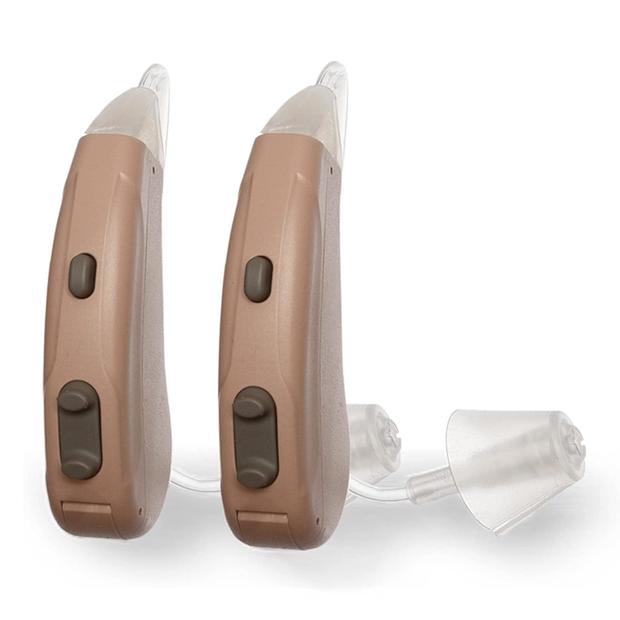Best hearing aids for profound hearing loss
Hearing loss of any severity can be devastating. Thankfully, hearing aids often help the more than 30 million people in the U.S. who currently live with some degree of hearing loss.
But what if deafness is at its most severe? Profound hearing loss only affects around 0.2% of people in the U.S., but its severity can be difficult to deal with on a daily basis.
For those with profound hearing loss, we recommend the best of the best when it comes to high-quality hearing aids.
One of the most important things you can do to combat profound hearing loss is to work with your audiologist or doctor to figure out the extent of your condition, as well as to pick out the right hearing aids for your needs. To make things easier, we've put together a list of the best hearing aids for profound hearing loss below.
What is the best hearing aid for profound hearing loss?
The best hearing aids for profound hearing loss offer an above-average selection of sound features. Factors like crisp sound amplification and clean background noise cancellation are a must. Thankfully, there are plenty of high-quality hearing aid devices out there to choose from. Here are the top brands and models for profound hearing loss in 2024:
- Top pick: Phonak Naída Paradise
- Runner up: Phonak Audéo Lumity
- Best features: Starkey
- Most comfortable fit: Oticon
- Most budget-friendly: Lexie
Shop the best hearing aids for profound hearing loss below.
Top pick: Phonak Naída Paradise
Phonak is at the top of our list; the brand's hearing aid devices are some of the best out there. One of the brand's most powerful hearing aids, the Naída Paradise, is perfectly suited for people with profound hearing loss, thanks to robust sound features and a comfortable behind-the-ear style that can comfortably stay put for hours at a time.
This hearing aid offers multi-channel and directional microphone systems that easily boost speech and other important sounds from all around you. The Naída Paradise also offers advanced noise reduction features and Bluetooth connectivity so that you can connect to other devices with ease.
Pros:
- Android-compatible mobile app adds additional options for programming and customizing your device.
- Hands-free calling, Bluetooth connectivity and other features make this a great all-around investment for people with moderate to profound hearing loss.
Cons:
- Some customers highlight a "glitch" with the tap controls that might require you to hit buttons or make selections multiple times for it to work correctly.
- Custom-made sound programs are lost and overridden any time you visit an audiologist and they perform a software update for your hearing aid.
Runner up: Phonak Audéo Lumity
We couldn't choose just one hearing aid from Phonak, so the brand made our list twice. Previously highlighted as our pick for the best BTE hearing aid, the Audéo Lumity comes in a close second following the Naída Paradise as one of the best devices you can invest in for help with profound hearing loss.
Improved speech-focused technology such as StereoZoom for front-facing conversations and SpeechSensor for improved hearing from the sides and back make this a powerful and effective hearing aid. This device also offers Bluetooth connectivity for both iOS and Android devices.
As a prescription hearing aid, the Phonak Lumity is available in four technology tiers, with more functionalities (and a higher price) tied to higher ones. These include L30 (essential), L50 (standard), L70 (advanced), and L90 (premium).
Prices start at around $1,800 for the lowest tier, the Lumity L30 hearing aid.
Pros:
- High-quality sound amplification from a trusted hearing aid brand.
- Multiple tech tiers can make it easy to find the right device for your needs (and your budget).
- Mobile app compatibility with iOS and Android devices.
Cons:
- MyPhonak app has conflicting reviews about user friendliness.
- Choosing the right tech tier can be overwhelming -- consult with your audiologist to find the right fit for you.
Best features: Starkey Genesis AI
The Genesis AI is the latest and greatest hearing aid from Starkey.
It aims to minimize how often you need adjust your hearing aid by adapting automatically. Sound technology tracks adjustments and gauges incoming sounds in real time. These AI-powered hearing aids then use this information to pick certain listening modes (like restaurant or TV mode).
Along with features like crisp Bluetooth connectivity, health tracking, and the best battery life we've seen yet in our reviews (up 51 hours on a single charge), this hearing aid already earned its spot on our list. But it's also the only hearing aid available right now that offers fall detection and language translation services.
This new and innovative hearing aid is available starting at around $2,400 per pair, but prices can vary considerably from one retailer to the next.
Pros:
- Robust sound amplification features make this hearing aid worth the high price tag.
- AI-powered "deep neural network" feature learns what sound programs and adjustments you need to offer an easy and automated listening experience.
- Unmatched battery life that lasts longer than 50 hours on a single charge.
Cons:
- Starkey mobile app may be confusing to new users.
Most comfortable fit: Oticon Real (BTE)
Oticon hearing aids are known for putting quality above all else, which is why its BTE model, Oticon Real, made our list. Oticon hearing aids come with some serious tech power, including tech that combines targeted hearing with adaptable background noise cancellation to make it easier than ever to hear.
Features like Oticon's BrainHearing and RealSound technology, which provides next-level sound clarity and environmental noise filtration, make this a great pick for anyone that doesn't want to spend time fine-tuning and adjusting their hearing aid throughout the day.
There are several variations of the Real BTE model to choose from, including the miniBTE T, which relies on disposable batteries, and the rechargeable miniBTE R device.
Pros:
- Robust and adaptable hearing technology means less time spent adjusting your device manually throughout the week.
- Simple design makes for a comfortable fit.
Cons:
- As with all prescription hearing aids, you'll likely need to talk with your audiologist to find a provider that can get you set up with a professional fitting.
Most budget-friendly: Lexie Lumen
The Lexie Lumen hearing aid has standout features and a price tag that's still half what you'd pay for quality prescription hearing aids, making this a worthy consideration for hearing aids that help with profound hearing loss.
Perfect for serious to profound levels of hearing loss, the Lexie Lumen hearing aid comes with multiple pre-programmable listening settings that can be matched with different environments and noise levels.
This hearing aid is also equipped with a telecoil setting that lets wearers bypass background noise and tap into nearby speakers -- useful whether you're at the movies, a museum, or a busy train station.
The Lexie Lumen hearing aid is currently marked down $100 from its original price from Lexie, as well as other retailers like Amazon.
Pros:
- Good background noise cancellation.
- Custom features make this hearing aid useful for a variety of scenarios.
Cons:
- No Bluetooth connectivity.
- As an OTC hearing aid, this device has a higher volume of customer reviews highlighting issues with sound quality than other, more expensive prescription hearing aids.
What is profound hearing loss?
Hearing loss is typically categorized into four levels. Your audiologist can help you determine which level best applies to you, which is important for selecting the right hearing aid for your needs. Profound hearing loss is -- as the name implies -- the most serious level of deafness. People in this category may not be able to hear anything at all, which is why choosing a powerful hearing aid that offers robust sound features can be so important.
The four levels of deafness are:
- Mild hearing loss or deafness. People in this category can only pick up sounds between 25 and 29 decibels (dB). Speech from those around you may sound garbled or hard to understand, especially if there is also background noise. Hearing aids may be recommended but not required at this stage.
- Moderate hearing loss or deafness. People in this category can only pick up sounds between 40 and 69 dB. Conversations are likely very hard to follow based on sound alone. A hearing aid is likely to be recommended at this stage and beyond.
- Severe hearing loss or deafness. People in this category can only pick up sounds between 70 and 89 dB. At this point, lip-reading or sign language is likely necessary for you to easily communicate with others. A hearing aid is likely needed to help counter the severe hearing loss.
- Profound hearing loss or deafness. People in this category can only pick up sounds above 90 dB. Alternative means of communications such as sign language are all but necessary at this point. A prescription hearing aid with reliable sound features is also very likely to be recommended by an audiologist.
What hearing aid is best for profound hearing loss?
There are smaller devices that fit entirely in the ear canal for a less noticeable look, while bulkier hearing aids have parts that sit comfortably behind and around the ear. The best design for profound hearing loss tends to be behind-the-ear (BTE) hearing aids, which have more room for high-tech equipment in the shell casing that sits comfortably behind your ear. These provide optimal sound amplification over other models.
Some of the other common styles you'll come across include:
- Receiver-in-the-canal (RIC). RIC hearing aids (as well as the smaller receiver-in-the-ear, or RITE, devices) are similar to a BTE in design, but with a connecting wire in place of the BTE's earmold. This gives the ear canal more room and results in a more comfortable fit.
- In-the-ear (ITE). ITE hearing aids are custom-made to sit entirely in the outer ear. These devices have a longer battery life and usually come with more features, such as volume control, than smaller models.
- Completely-in-the-canal (CIC). CIC hearing aids have the smallest design, with a custom-built shell that fits in the ear canal. These are the least noticeable, but don't offer many features or the most powerful sound amplification.
- Open fit. A variation of a BTE, an open-fit hearing aid has an over-the-ear design with an open dome in the canal instead of a tube or mold. This keeps the ear canal open for natural sound to enter the ear as well – ideal for mild to moderate hearing loss.
How we chose the best hearing aids for profound hearing loss
For a closer look at how we rate certain products and services, here is what we prioritized while looking at the best hearing aids for profound hearing loss:
- Sound quality: We looked for important features like deep background noise cancellation and crisp speech amplification.
- Tech features: We paid attention to features like reliable Bluetooth connectivity, consistent sound quality and crisp noise amplification to make sure we highlight the best of the best.
- Customer reviews: All of our hearing devices hold a four-star review or higher from happy customers just like you.
- Comfort: We paid attention to the design, shape, and fit of each hearing aid to ensure only the most comfortable hearing aids made the list.





